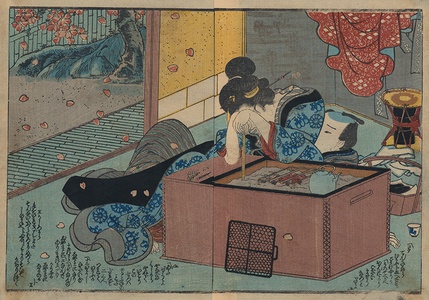| Method | Woodblock (nishiki-e) |
| Artist | Utagawa Kuniyoshi (1797-1861) |
| Published | after Tenpo 8 1837 |
| Dimensions | Two Hanshibon sheets [each sheet ~222 x 155 mm] |
| Notes |
Series Title: Gyokueki chiwa hannah ikada: Clusters of Flowers by a Stream Author: Kōshoku Gaishi pseudonym of Hanagasa Bunkyō in collaboration with Adano Sanjin A print from Volume I of Kunyoshi's Gyokueki chiwa hannah ikada: Clusters of Flowers by a Stream. In this print lovers sit next to a kamado (stove) with a kettle in it, cherry blossom petals from a cherry tree outside blow through the open door. The woman rests her hand on chopsticks covering her face, behind her a man whose face is partly obscured is leaning back on his left hand, a cup sits near by. This is an example of abuna-e print which is suggestive and not overtly explicit. Shunga is the term used for the body of erotic imagery produced in Japan from 1600 to 1900. The term shunga means spring pictures, a euphemism for sex, and is one of several names for erotic material produced in Japan. Shunga took different formats: painted hand scrolls, painted books, printed books and albums, and sets of prints which were sometimes sold in wrappers. As prints they are one of the genres of ukiyo-e, or Floating World prints, which also include fukeiga (landscape prints), and bijin-ga (prints of beautiful women). Most of the major ukiyo-e artists produced shunga material at some point during their careers, including Utamaro (who produced more erotic books than non-erotic books), Hokusai, and Hiroshige. Produced at the same time as the introduction of full colour woodblock printing, shunga prints and books were made using the most lavish and complicated printing techniques, including gauffrage, metallic inks, mica, complicated printed patterns, and multicolour printing using a high number of different colours. Although prolific in its number and variety, shunga should be seen as more representative of the ideals of the ukiyo, with its emphasis on mutual pleasure, rather than as an accurate representation of Japanese attitudes and practices of sexuality. Shunga present an invitation to pleasure through the bliss of lovemaking and though largely heteronormative, they portray the full gamut of couplings, married or otherwise, often surrounded by lavish settings and objects of pleasure. Utagawa Kuniyoshi (1797-1861) joined the famous Utagawa School, then headed by the great master Toyokuni Utagawa (1769 - 1825) at the age of fourteen. According to other sources, he had been trained by Katsukawa Shuntei before this. Kuniyoshi achieved his commercial and artistic breakthrough in 1827 with the first six designs of the series The Hundred and Eight Heroes of the Suikoden. The series was about one hundred and eight rebels and honorary bandits, based on an old Chinese novel from the fourteenth century. The story was very popular in Japan. The artist continued with this pattern of success and concentrated on print subjects of warriors and heroes. He was even nicknamed Warrior Print Kuniyoshi. After being financially settled, he turned to other subjects - ghost stories, comic prints, landscapes, beautiful women and actor prints. The artist also tried his luck with another subject, natural life prints, showing animals like birds, fish and cats. These kinds of new subjects, like the landscape print, had first been made popular by Ando Hiroshige. Since the early 1840s, Kuniyoshi prints show some influence of western style painting and printmaking. The artist possessed a collection of western engraving prints. He admired them as much as the European Impressionist artists would admire Japanese woodblock prints later. Western influence can be found in Kuniyoshi prints in several ways: the use of the Western perspective, the way he designed clouds and the way he tried to show the effects of light and shadow. Additonally Kuniyoshi was a great lover of cats with his studio apparently full of them and frequently depicting them in his prints. In terms of his shunga output he produced at least 43 known titles during his career with titles recorded 1829-1857 and he depicted the full range of Edo couplings in this work. Kuniyoshui used the following pseudonyms: Nekoyoshi (cats are good), Hakubyôkai Hodoyoshi (happy keeper of white cats), Gobyôtei Hodoyoshi (five cat home–just right), and Sanbentei Nekoyoshi (the Sanbentei cat lover). Ex. Col.: Peter Darach Reference: International Research Centre for Japanese Studies, Ehon (Uliyo-e Shunga) Database, Kyoto, KC/172/Ka, 001271097. The Gerhard Pulverer Collection, Freer Gallery of Art, Smithsonian, Washington D.C, FSC-GR-780.26.1-3 Condition: Very good. Some rubbing to left and right bottom corners, light stain to lower left corner, small loss to lower right margin not affecting the image. |
| Framing | unmounted |
| Price | £350.00 |
| Stock ID | 53185 |

